A forced swim-based rat model of premenstrual depression: effects of hormonal changes and drug intervention
- PMID: 33229622
- PMCID: PMC7762461
- DOI: 10.18632/aging.202249
A forced swim-based rat model of premenstrual depression: effects of hormonal changes and drug intervention
Abstract
Premenstrual dysphoric disorder (PMDD), a form of premenstrual syndrome (PMS), is a severe health disturbance that affects a patient's emotions; it is caused by periodic psychological symptoms, and its pathogenesis remains unclear. As depression-like symptoms are found in a majority of clinical cases, a reliable animal model of premenstrual depression is indispensable to understand the pathogenesis. Herein, we describe a novel rat model of premenstrual depression, based on the forced swimming test, with a regular estrous cycle. The results showed that in the estrous cycle, the depression-like behavior of rats occurred in the non-receptive phase and disappeared in the receptive phase. Following ovariectomy, the depression-like symptoms disappeared and returned after a hormone priming regimen. Moreover, fluoxetine, an anti-depressant, could reverse the behavioral symptoms in these model rats with normal estrous cycle. Further, the model rats showed significant changes in the serum levels of estrogen and progesterone, hippocampal levels of allopregnanolone, 5-hydroxytryptamine, norepinephrine, and γ-aminobutyric acid (GABA), and in the expression of GABAA receptor 4α subunit, all of which were reversed to physiological levels by fluoxetine. Overall, we established a reliable and standardized rat model of premenstrual depression, which may facilitate the elucidation of PMS/PMDD pathogenesis and development of related therapies.
Keywords: Gabra4; animal model standardization; estrus cycle; forced swimming test; premenstrual dysphoric disorder.
Conflict of interest statement
Figures

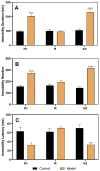
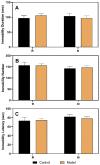
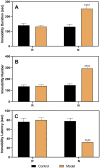
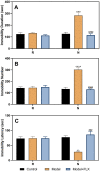
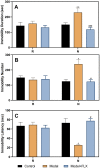



Similar articles
-
Resident intruder paradigm-induced PMDD rat model of premenstrual irritability: behavioral phenotypes, drug intervention, and biomarkers.Aging (Albany NY). 2022 Nov 27;14(22):9210-9220. doi: 10.18632/aging.204402. Epub 2022 Nov 27. Aging (Albany NY). 2022. PMID: 36441533 Free PMC article.
-
ShuYu capsule alleviates emotional and physical symptoms of premenstrual dysphoric disorder: Impact on ALLO decline and GABAA receptor δ subunit in the PAG area.Phytomedicine. 2024 Jul 25;130:155549. doi: 10.1016/j.phymed.2024.155549. Epub 2024 Mar 19. Phytomedicine. 2024. PMID: 38810551
-
Attenuation of estrous cycle-dependent marble burying in female rats by acute treatment with progesterone and antidepressants.Psychoneuroendocrinology. 2007 Jul;32(6):651-9. doi: 10.1016/j.psyneuen.2007.04.003. Epub 2007 Jun 11. Psychoneuroendocrinology. 2007. PMID: 17561352
-
The Menstrual Cycle Influences Emotion but Has Limited Effect on Cognitive Function.Vitam Horm. 2018;107:349-376. doi: 10.1016/bs.vh.2018.01.016. Epub 2018 Feb 19. Vitam Horm. 2018. PMID: 29544637 Review.
-
Effects of GABA active steroids in the female brain with a focus on the premenstrual dysphoric disorder.J Neuroendocrinol. 2018 Feb;30(2). doi: 10.1111/jne.12553. J Neuroendocrinol. 2018. PMID: 29072794 Review.
Cited by
-
The Problem of Malnutrition Associated with Major Depressive Disorder from a Sex-Gender Perspective.Nutrients. 2022 Mar 6;14(5):1107. doi: 10.3390/nu14051107. Nutrients. 2022. PMID: 35268082 Free PMC article. Review.
-
Gabrb2 knock-out mice exhibit double-directed PMDD-like symptoms: GABAAR subunits, neurotransmitter metabolism disruption, and allopregnanolone binding.Aging (Albany NY). 2022 Oct 24;14(20):8437-8447. doi: 10.18632/aging.204351. Epub 2022 Oct 24. Aging (Albany NY). 2022. PMID: 36287173 Free PMC article.
-
Baseline beliefs about medication are associated with outcomes of antidepressants in inpatients with first-diagnosed depression under supervised therapeutic compliance.Aging (Albany NY). 2021 Sep 2;13(17):21400-21407. doi: 10.18632/aging.203477. Epub 2021 Sep 2. Aging (Albany NY). 2021. PMID: 34473643 Free PMC article.
-
Agomelatine might be more appropriate for elderly, depressed, type 2 diabetes mellitus patients than paroxetine/fluoxetine.Aging (Albany NY). 2021 Oct 5;13(19):22934-22946. doi: 10.18632/aging.203586. Epub 2021 Oct 5. Aging (Albany NY). 2021. PMID: 34610580 Free PMC article. Clinical Trial.
-
Editorial: Neural circuits and neuroendocrine mechanisms of major depressive disorder and premenstrual dysphoric disorder: Toward precise targets for translational medicine and drug development.Front Psychiatry. 2022 Jul 26;13:983604. doi: 10.3389/fpsyt.2022.983604. eCollection 2022. Front Psychiatry. 2022. PMID: 35958656 Free PMC article. No abstract available.
References
-
- Eisenlohr-Moul TA, Kaiser G, Weise C, Schmalenberger KM, Kiesner J, Ditzen B, Kleinstäuber M. Are there temporal subtypes of premenstrual dysphoric disorder?: using group-based trajectory modeling to identify individual differences in symptom change. Psychol Med. 2020; 50:964–72. 10.1017/S0033291719000849 - DOI - PMC - PubMed
-
- Yakir M, Klein-Laansma CT, Kreitler S, Brzezinski A, Oberbaum M, Vithoulkas G, Bentwich Z. A placebo-controlled double-blind randomized trial with individualized homeopathic treatment using a symptom cluster approach in women with premenstrual syndrome. Homeopathy. 2019; 108:256–69. 10.1055/s-0039-1691834 - DOI - PubMed
Publication types
MeSH terms
Substances
LinkOut - more resources
Full Text Sources
Medical
Research Materials

